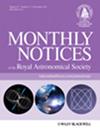超漫反射星系光谱特性目录与分析
IF 4.8
3区 物理与天体物理
Q1 ASTRONOMY & ASTROPHYSICS
引用次数: 0
摘要
为了促进未来对超漫反射星系(UDG)的研究,我们编制了一份超漫反射星系光谱特性目录。利用这份目录,我们研究了当前UDG样本中一些固有的偏差。与通过光谱能量分布(SED)研究的更大 UDG 样本相比,目前的光谱目标本质上更亮、恒星质量更高、体积更大、球状星团更丰富、年龄更大、金属性分布更广。特别是,许多通过光谱研究的 UDG,其恒星质量的很大一部分都包含在其球状星团(GC)系统中。我们还在目录中寻找参数之间的相关性。值得注意的是α元素丰度与金属性之间的相关性,这在 "失败星系 "的情况下是可以预料到的。然而,我们并没有发现预期的金属性与年龄之间的相关性,目前还不清楚这是否是反对 "失败星系 "假设的证据,或者仅仅是由于统计数量较少和存在异常值造成的。最后,我们尝试用机器学习的K-means方法将我们的目录划分为不同的类别。我们发现聚类的效果很弱,目前还没有必要把目录分成多个不同的子群。我们的目录可在网上查阅,我们的目标是在这项工作发表后继续维护它。本文章由计算机程序翻译,如有差异,请以英文原文为准。
A Catalogue and Analysis of Ultra-Diffuse Galaxy Spectroscopic Properties
In order to help facilitate the future study of ultra-diffuse galaxies (UDGs) we compile a catalogue of their spectroscopic properties. Using it, we investigate some of the biases inherent in the current UDG sample that have been targeted for spectroscopy. In comparison to a larger sample of UDGs studied via their spectral energy distributions (SED), current spectroscopic targets are intrinsically brighter, have higher stellar mass, are larger, more globular cluster-rich, older, and have a wider spread in their metallicities. In particular, many spectroscopically studied UDGs have a significant fraction of their stellar mass contained within their globular cluster (GC) system. We also search for correlations between parameters in the catalogue. Of note is a correlation between alpha element abundance and metallicity as may be expected for a ‘failed galaxy’ scenario. However, the expected correlations of metallicity with age are not found and it is unclear if this is evidence against a ‘failed galaxy’ scenario or simply due to the low number statistics and the presence of outliers. Finally, we attempt to segment our catalogue into different classes using a machine learning K-means method. We find that the clustering is very weak and that it is currently not warranted to split the catalogue into multiple, distinct sub-populations. Our catalogue is available online and we aim to maintain it beyond the publication of this work.
求助全文
通过发布文献求助,成功后即可免费获取论文全文。
去求助
来源期刊

Monthly Notices of the Royal Astronomical Society
ASTRONOMY & ASTROPHYSICS-
CiteScore
9.10
自引率
37.50%
发文量
3198
审稿时长
3 months
期刊介绍:
Monthly Notices of the Royal Astronomical Society is one of the world''s leading primary research journals in astronomy and astrophysics, as well as one of the longest established. It publishes the results of original research in positional and dynamical astronomy, astrophysics, radio astronomy, cosmology, space research and the design of astronomical instruments.
 求助内容:
求助内容: 应助结果提醒方式:
应助结果提醒方式:


